Crucification
I will spend little time here discussing the various colourful ways by means of which I have been depicted:
- unreliable source of information
- fame-seeking blogger
- Paris Hilton of Physics
- Less trustworthy than Paul the Octopus
- and I could go on, but I prefer to leave these envious utterings where they first diffused their stench.
I am amused by the attention, but rather disappointed by the utter failure of all these commentators to understand what went wrong here: the press jumped at this gossip, without a blink, where there simply was no story !
In fact, I said it from the outset of my original post: I knew nothing. This is therefore a textbook example of something out of nothing: a lot of media hype about a stated zero-information text.
Do I feel guilty ? Of what ! Of having gotten the Higgs boson in the press once again ? Come on -it only does good to Science to get people interested in High-Energy Physics. Of having cried wolf, to the detriment of fund collection by experiments ? Give me a break. The people who act as reviewers and who distribute funds to experiments are a lot smarter than me and you, and they know perfectly well how this media system works.
It must be the fear of the dumb congressman. Sure, but the dumb congressman has done a lot of damage in the past -we should have grown ways to prevent such pitfalls as the cancelation of the SSC by now. Or are you willing to blame yours truly for that too ?
I am really a patient person, but I am tired of explaining these things. I can only say that old ideas die with the people who support them, and new ideas run those people over. Have fun, whether you are taking the part of the asphalt or the wheel in this rather undramatic play.
The Facts (Not Gossip)
The DZERO search for
 events, which provides a complementary view of the same supersymmetric Higgs particle (actually, two almost degenerate states, in part of the parameter space) from the one recently published by CDF, evidences a similar, albeit smaller, excess of signal-like events that the former search did. Is this what some theorist got excited about ?
events, which provides a complementary view of the same supersymmetric Higgs particle (actually, two almost degenerate states, in part of the parameter space) from the one recently published by CDF, evidences a similar, albeit smaller, excess of signal-like events that the former search did. Is this what some theorist got excited about ?Let us have a look at the graphs. The one from CDF, obtained by searching for an excess in the mass distribution of pairs of b-quark jets in events containing a third b-jet (and discussed a month ago here), is shown below.
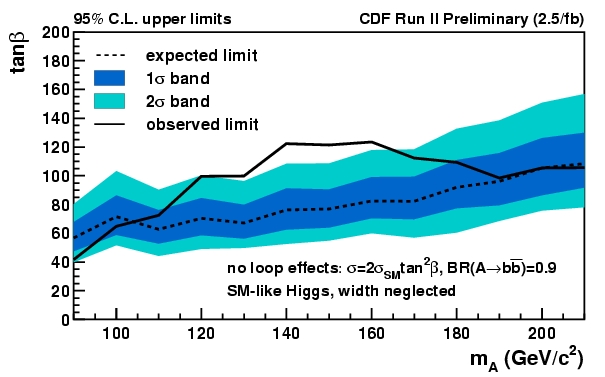
Before you start wondering what the graph shows, it is best to explain what is an "expected limit". Basically, before they actually look at real data, the analysts determine what is the limit on the parameter space (in this case, the parameter called "tan(beta) as a function of mass of a Higgs particle called "A") that the amount of data in their hands, and the search methodology, grant on average. Average here is a unfortunate word: what the "expected limit" curve shows is actually the median of a distribution of limits extracted from a large ensemble of pseudo-datasets, all constructed under the hypothesis that no signal is present.
In the graph you can see a wide light-blue band and a smaller dark-blue band. These determine where the actual limit calculated with real data should fall, 95% of the time (the yellow band) and 68% of the time (the green band).
The departure of the observed limit in tan(beta) /the black line) from the expected limit (the hatched line at the center of the "expectation" band) does not mean much -something like that does happen a few times in a hundred, in the absence of any Higgs signal. But it does say that CDF did see more data compatible with a 130 to 160 GeV Higgs boson than they predicted. Of course, nothing to get excited about -the more so since such broad-band searches for a particle of unknown mass are liable to yield some significant departure, here or there in the analyzed spectrum. This is the so-called "look-elsewhere effect", which I have aptly discussed elsewhere.
Now let us look at an independent search from DZERO -the one released yesterday by Marco Verzocchi at the Wine and Cheese Fermilab seminar. They have looked for the same signal -supersymmetric Higgs bosons- produced in the same way (associated with a b-quark) but decaying to a different final state: a pair of tau leptons. Higgs bosons at high values of the tan(beta) parameter do like to decay to b-quarks or tau leptons, because of their increased coupling to such bodies.
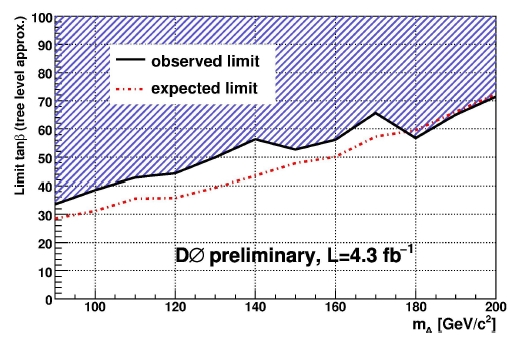
The DZERO tan(beta) limit is also larger than the expectation. But how much so ? The graph does not say, due to the absence of 1- and 2-sigma expectation bands. One needs to fetch that information in another graph produced by DZERO, where the cross section is plotted on the vertical scale rather than the critical tan(beta) parameter. Still, the information is there. Have a look.
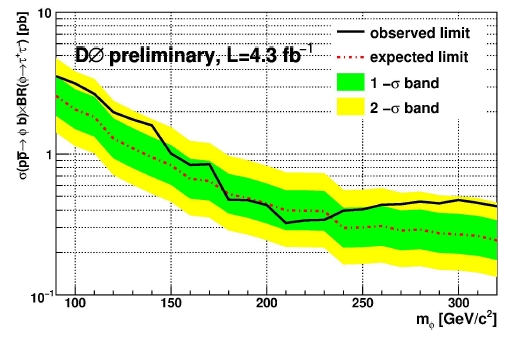
Here you can see that DZERO does see a very mild, but not insignificant, upper fluctuation of their data, since the observed cross section limit is higher than the expected one by about 1.5 standard deviations, for Higgs masses between 120 and 140 GeV.
So what is a sound way to address this combined information ? One way to take a conservative stand would be to say that the CDF excess pointed to a MSSM-like 140 GeV Higgs boson decaying to b-quark pairs (I abstain to discuss the detailed phenomenology of the five Higgs states of their theory, but they are mostly irrelevant here). Once that observation is in the bag, one may say "fine -we see something odd there, now let us forget about that "evidence" and seek independent confirmations".
If that stand is taken, one should conclude that DZERO provides a 1.5-sigma "confirmation" (please put the word in the right context) of the CDF excess. Too little to get excited, definitely, but still something to watch closely in the future.
If, on the other hand, one were to hard-nosedly combine the two observations by CDF and DZERO (and I know for a fact that there are theorists who are doing precisely that kind of exercise), we would get a 2.5 plus 1.5 sigma hint at about 135 GeV. Now, significances which are uncorrelated add in quadrature, which means that you first square them, then add them, and finally take the square root of the result. What do we get ?
We get a roughly 3-sigma indication of a MSSM Higgs boson in that mass range. Is this what some of the voices I overheard (and reported as rumours, getting crucified despite my self-confidence of not doing anything wrong) got excited about ? Apparently, yes. But is it right ? Well, yes and no - the tan(beta) regions do not coincide. A real combination of the results would need to be carried out, but this is highly unlikely to happen in the near future, unless things grow more interesting by adding more data. Theorists will be happy to continue speculating on the effect, but admittedly there is not much more press to publish on the matter, for now.
My Take
I have said it before; I have bet $1000 on it; I have repeated it ad nauseam. I feel compelled to say it again: I do not believe it is a real signal. I think it is a fluctuation. I do not believe in Supersymmetry. I think these searches are underestimating their systematical uncertainties in the QCD background.
That said, you might probably wonder why the heck I have made a fuss about the rumours. The answer is simple: I haven't!!! I have reported two corridor voices, explicitly saying that I knew nothing about it, and that I believed they were not anything trustable. Watch the result: dozens of newspapers jump at the story, Fermilab feels compelled to negate the rumour, spokespersons dub me a unreliable source of information, people liken me to Paris Hilton or Paul the Octopus. What a bunch of clowns. They do not realize that they are the clowns, not me. Can you explain, otherwise, how a Fermilab joint experimental-theoretical physics seminar becomes a place where two out of 45 slides of a highly anticipated talk are devoted to having fun of my blog and my person ?
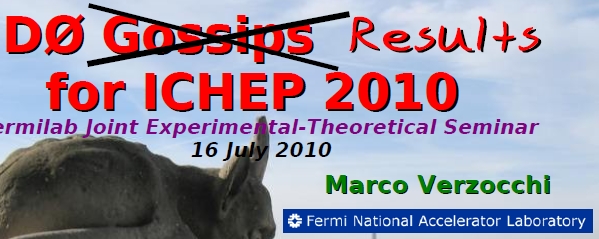
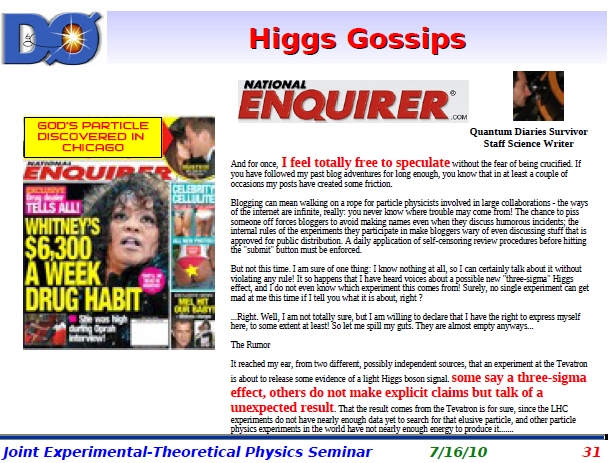

I am mostly amused, nonetheless: the "Paul the Octopus" slide by Marco Verzocchi is really funny. I have my reservations on the way he used his seminar time, but admittedly my money does not pay his salary, while some of you cannot say the same.




Comments